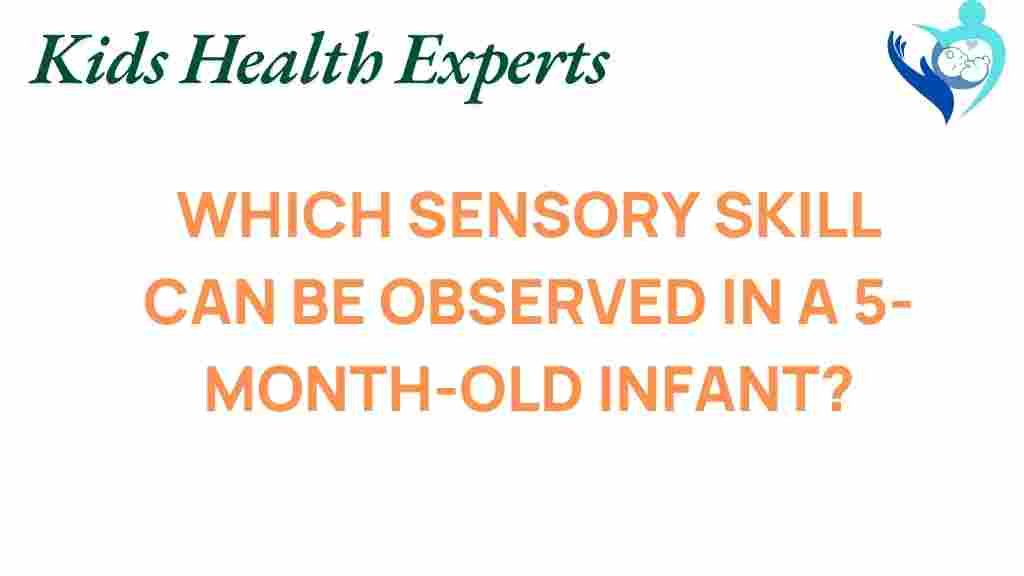Unveiling the Surprising Sensory Skill of a 5-Month-Old Infant: Understanding Sensory Development
As parents and caregivers, witnessing the growth and development of an infant is a truly magical experience. One of the most fascinating aspects of this journey is the sensory development of a 5-month-old infant. During this stage, infants begin to engage more actively with their environment, showcasing a range of skills that are pivotal for their cognitive growth. This article will delve into the various aspects of sensory exploration, infant skills, and the developmental milestones that occur during this crucial period, providing valuable parenting insights.
The Importance of Sensory Development
Sensory development refers to the way infants learn to interpret and respond to the world around them through their senses. At five months, babies are in a critical stage of growth that lays the foundation for future learning and exploration. Understanding this process helps parents and caregivers facilitate their child’s development more effectively.
Key Sensory Skills of a 5-Month-Old
At five months, infants exhibit surprising sensory skills that reflect their ongoing cognitive growth. Here are some key areas of development to observe:
- Tactile Sensitivity: Babies begin to explore textures and temperatures, showing preferences for different surfaces.
- Visual Tracking: Infants can follow moving objects with their eyes, indicating their developing visual skills.
- Auditory Discrimination: Five-month-olds start to recognize familiar sounds and voices, which aids in their social interactions.
- Oral Exploration: Babies will use their mouths to explore objects, which is a natural part of sensory exploration.
Understanding Infant Skills Through Child Observation
Child observation is a key tool for parents seeking to understand their baby’s behavior and skills. By closely observing your 5-month-old, you can gain insights into their sensory development and overall growth. Here are some tips on how to effectively observe your infant:
- Engage in Play: Use toys that stimulate the senses, such as rattles or soft books.
- Vary Environment: Change the setting to expose your baby to new sounds and sights.
- Watch for Reactions: Note how your baby responds to different stimuli, such as textures or sounds.
Steps to Facilitate Sensory Exploration
To encourage sensory development in your 5-month-old, consider the following steps:
- Provide Sensory Toys: Offer toys that have different textures, colors, and sounds to engage your baby’s senses.
- Encourage Tummy Time: This activity not only strengthens muscles but also allows babies to explore their environment from a different angle.
- Introduce Nature: Take your baby outdoors to experience natural sounds, sights, and textures.
- Read to Your Baby: Engage in reading with varied tones and expressions to enhance auditory skills.
Understanding Baby Behavior During This Stage
As infants grow, their behavior will change in response to their developing sensory skills. Here are some typical behaviors to expect:
- Increased Curiosity: Your baby may show more interest in exploring their surroundings.
- More Social Interaction: Expect smiles, cooing, and attempts to communicate.
- Refusing Certain Textures: Babies may show preferences or aversions to certain materials during exploration.
Common Challenges and Troubleshooting Tips
While observing your infant’s sensory development, you may encounter challenges. Here are some common issues and troubleshooting tips:
- Overstimulation: If your baby seems fussy or overwhelmed, reduce sensory input by creating a calm environment.
- Limited Interest: If your baby isn’t engaging with toys, try different types or textures to reignite their curiosity.
- Preference for Certain Activities: If your child prefers one type of play, encourage variety by introducing new sensory experiences gradually.
Developmental Milestones at 5 Months
At five months, infants typically reach several developmental milestones that are critical to their growth. These include:
- Rolling Over: Many babies can roll from tummy to back and vice versa.
- Grasping Objects: Improved hand-eye coordination allows them to reach for and grasp toys.
- Vocalizing Sounds: Expect more cooing, gurgling, and attempts to imitate sounds.
These milestones serve as indicators of your baby’s cognitive and physical development, providing insights into their sensory exploration capabilities.
Enhancing Cognitive Growth Through Sensory Play
Engaging your infant in sensory play is essential for their cognitive growth. Here are some activities to consider:
- Water Play: Fill a shallow container with water and let your baby splash and explore.
- Texture Exploration: Create a sensory board with different materials for your baby to touch.
- Sound Exploration: Use instruments like maracas or bells to stimulate auditory senses.
Parenting Insights: What to Remember
Observing and facilitating your baby’s sensory development can be both rewarding and challenging. Here are some parenting insights to keep in mind:
- Patience is Key: Every baby develops at their own pace; celebrate small victories.
- Follow Your Baby’s Lead: Let your infant guide you in exploring their interests and preferences.
- Stay Engaged: Your involvement and interaction are crucial for your baby’s learning and development.
The Role of Environment in Sensory Development
The environment plays a significant role in sensory exploration. A stimulating environment can enhance your baby’s sensory experiences. Consider the following:
- Safe Spaces: Create areas where your baby can explore safely without hazards.
- Varied Experiences: Regularly change surroundings to keep your baby engaged.
- Social Interaction: Encourage interactions with other babies and caregivers for social and sensory development.
Conclusion
Understanding the surprising sensory skills of a 5-month-old infant opens a window into the fascinating world of early childhood development. By observing your child’s behavior and encouraging sensory exploration, you can support their cognitive growth and help them reach important developmental milestones. Remember, every baby is unique, and fostering a nurturing environment that promotes sensory development can lead to delightful discoveries for both parents and infants. For more resources on child development, consider visiting this helpful guide.
As you embark on this beautiful journey of parenting, embrace each moment of exploration, and trust your instincts as you nurture your child’s sensory skills.
For further insights into parenting strategies, check out our parenting tips section.
This article is in the category Growth and created by KidsHealthExperts Team
